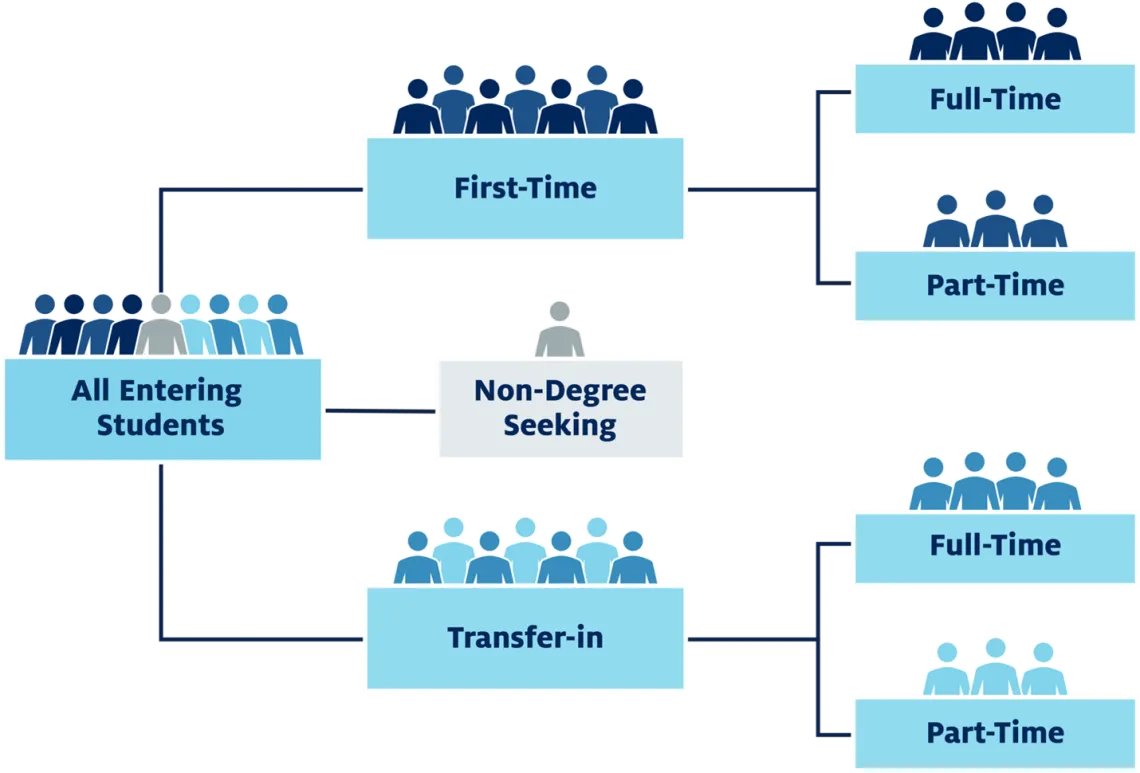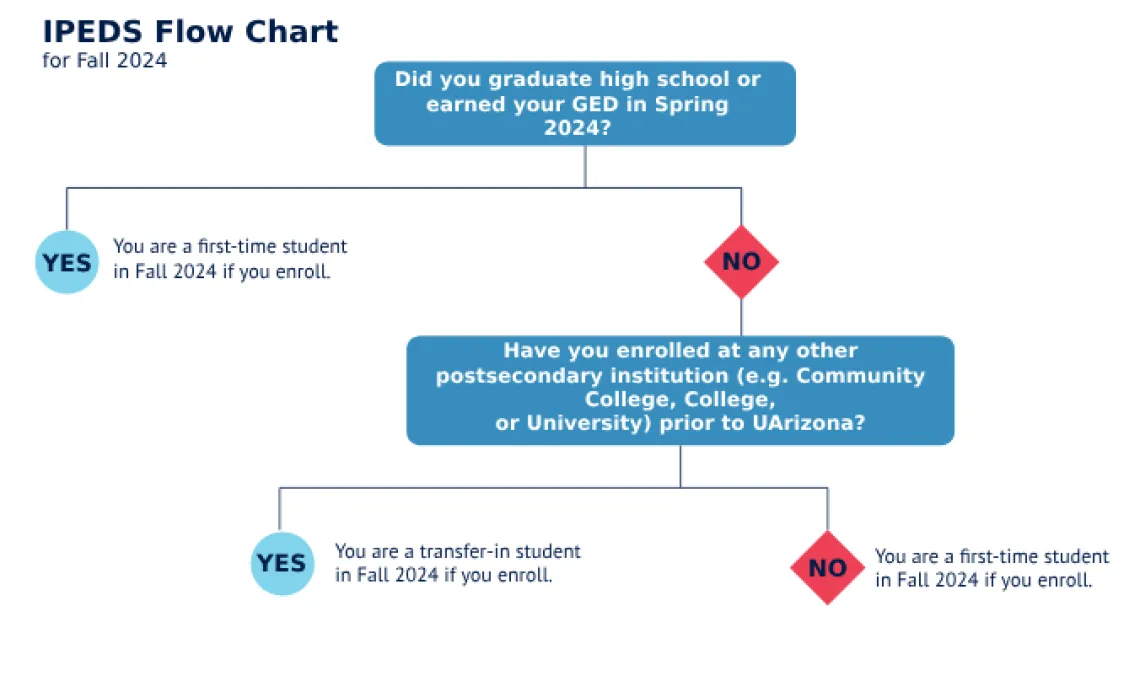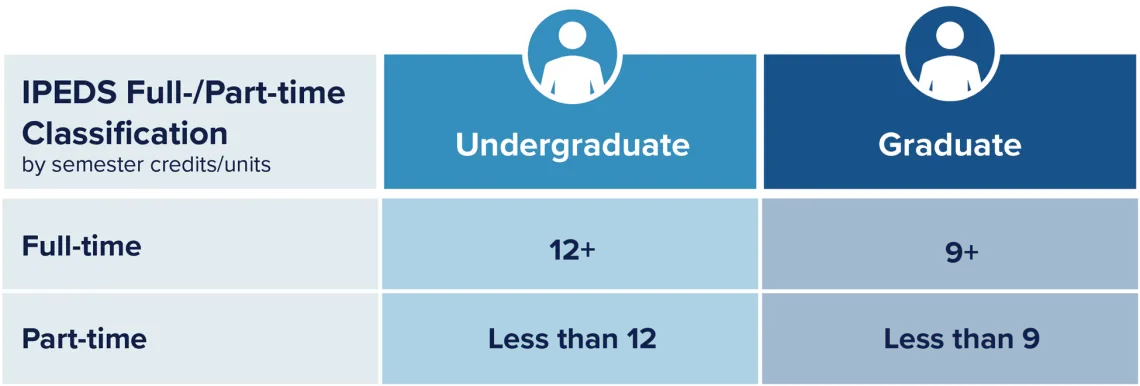Below are Frequently Asked Questions for student categorizations, cohorts, degrees, and other designations for students according to definitions from IPEDS (Integrated Postsecondary Education Data System). If you have a specific question that is not answered below, please reach out to UAIR's External Reporting Team at uair-ext-rpt@list.arizona.edu.
Included: All students enrolled for credit—that can be applied towards the requirements for a postsecondary award—regardless of whether they are seeking the award.
- Students taking UArizona for-credit courses offered at Southern Arizona Learning Centers (e.g. Pima Community College East and UA South)
- High school students enrolled in UArizona Community campus for-credit courses
- Students taking both remedial and for-credit courses if the student is degree-seeking for the purposes of financial aid determination
- Students enrolled in Arizona Online courses regardless of residential location
- Graduate students enrolled for thesis credits, even when zero credits are awarded
- Graduate students enrolled for credit while not seeking a degree or certificate
Excluded: Students who are not enrolled for credit.
- Students exclusively enrolled in courses that cannot be applied towards a recognized postsecondary credential (e.g. Osher Lifelong Learning Institute courses)
- Students only enrolled in an ESL program at the Center for English as a Second Language
- Students enrolled exclusively in continuing education units
- Students exclusively auditing classes
- Students only taking remedial courses during a reporting period
- Residents or interns in doctor's - professional practice programs, since they have already received their doctor's degree
In addition, the following students are excluded:
- UArizona students studying abroad who are not enrolled in UArizona classes during the study abroad period
- UArizona students enrolled for credit at a UArizona Global campus (locations in a foreign country)
Undergraduate students enrolled at the University of Arizona fall into one of three categories: first-time student, transfer-in student, or continuing/returning student.
A cohort is a specific group of students established for tracking purposes. Students are grouped into a cohort year based on when they began attending college. Students in a cohort are either first-time or transfer-in.
The University of Arizona calculates the official retention and graduation rates using the first-time, full-time undergraduate fall cohort.

According to the IPEDS Glossary, a first-time student is “A student who has no prior postsecondary experience attending any institution for the first time at the undergraduate level.” This means that the student is first-time in terms of postsecondary education (or the student is not known to have attended another postsecondary institution).
There are two exceptions which do not count as postsecondary education: (1) students who enroll in summer immediately prior to the fall term in which first-time enrollment occurs, and (2) students who entered with advanced standing.
First-time students can be of any age, although the average age is 18.
Advanced standing means that college credits were earned before graduation from high school. This could be from dual enrollment (e.g. collegiate enrollment during high school) or testing credit (e.g. Advanced Placement exams). Advanced standing does not count as postsecondary experience.
- Students who graduated from high school or earned their GED the spring prior to their enrollment in the fall term. (e.g. Students who graduated from high school or earned their GED in Spring 2024 and begin at UArizona in Fall 2024 would be reported as a first-time student in Fall 2024).
- Students who graduated from high school or earned their GED many years ago and this will be their first postsecondary enrollment. (e.g. Students who never attended any postsecondary institution prior to UArizona and enroll in either the Summer 2024 or Fall 2024 semesters would be reported as a first-time student in Fall 2024).
- Dual enrollment students who have earned collegiate credit while pursuing their high school diploma. (e.g. Students who graduated from high school in Spring 2024 with collegiate enrollment credits during high school and began at UArizona in Fall 2024 would be reported as a first-time student in Fall 2024.)
- Students who enrolled at the institution the summer prior to the fall term in which first-time enrollment is reported. (e.g. Students who graduated from high school or earned their GED in Spring 2024 and began at UArizona in Summer 2024 would be reported as a first-time student in Fall 2024).

A transfer-in student is a student who enters UArizona for the first time but is known to have previously attended a postsecondary institution at the same level (e.g. undergraduate, graduate). The student may transfer with or without credit.
- A student who enrolled at UArizona in Summer 2023 and had no other postsecondary experience in all of 2023, and then returned in Spring 2024 or after. This student is considered a continuing student.
- A student who enrolled at UArizona in Summer 2023 and obtained postsecondary experience in Fall 2023 (or after) from another institution, and then returned to UArizona. This student is considered a continuing student.
- A student who enrolls at UArizona after the 21st day of class in the fall or spring term. If that student is included in any future reporting, they will have earned postsecondary experience at the home institution and no longer be eligible to cohort as a first-time or transfer-in student. This student is considered a continuing student.
IPEDS classifies students as full-time and part-time based on the number of credits or units the student is enrolled in at the university. See the table below for details.

The University of Arizona collects data on the number of students who complete a postsecondary education program (completers) and the number of postsecondary awards earned (completions). These counts are reported every fall to IPEDS.
A completion is an award conferred by a college, university, or other postsecondary education institution as official recognition for the successful completion of a program of study. Synonyms for completion include ‘Degree’ and ‘Award’.
UAccess Student tracks degree completion information processed by UArizona’s Office of the Registrar. The degree status date determines fiscal year range (July 1 - June 30) for the reported completion. Degrees with a status of awarded are reported to IPEDS. One degree number in UAccess Student system equals one completion. Secondary majors are only reported for Bachelors degrees. Graduate plans listed as a secondary major will not be reported as a completion to IPEDS.
A completer is a student who is awarded a degree, diploma, certificate, or other recognized postsecondary credential. Synonyms for completer include ‘Degree Recipient’, ‘Award Recipient’, and ‘Graduate’.
One student may be granted multiple awards during an academic year (e.g. a dual degree). Thus, it is very likely that the university’s count of completions (awards) is greater than its count of completers (award recipients). For more information on completions visit the IPEDS Completions Brochure.
